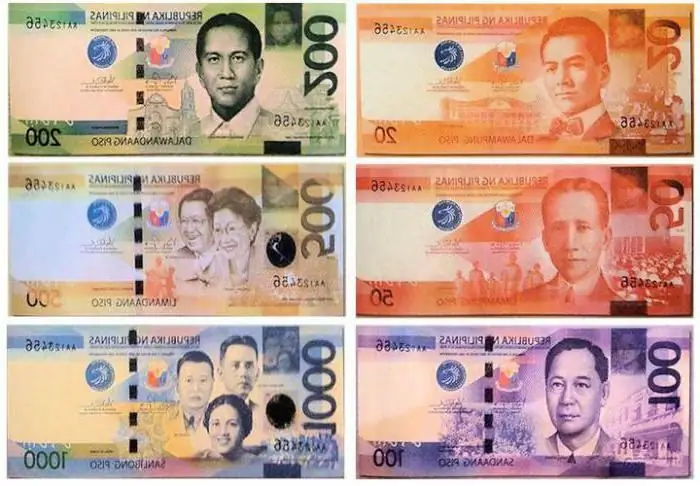2026 Author: Howard Calhoun | [email protected]. Last modified: 2025-01-24 13:10:26
In Indonesia, the official currency is the local rupiah. The symbol Rp is used to designate the monetary unit. It should be noted that in financial markets such as Forex, the Indonesian rupiah is referred to as IDR. In addition, this currency is often informally called Perak ("silver" in Indonesian).
History of the rupee. Currency banknotes
At the moment, denominations of one thousand, two thousand, five thousand, ten thousand, twenty thousand, fifty thousand and one hundred thousand rupees take part in circulation in the country. For a long period of time, the Indonesian government tightly regulated the exchange rate of the national currency.

However, in 1987, the country's leadership changed its monetary policy and abandoned control over the national currency. It was decided to give the Indonesian rupiah the so-called "free float". In addition, this unit was tied to a multi-currency basket, which included seven world currencies, one of which was the US dollar. Today the Indonesian rupiah has a ratio of 1 USD=13 549.32 IDR to the dollar.
In fact, the Central Bank of Indonesia handled the quotes of the rupee. Setting the exchange rate for the currencythis institution took into account the position of the rupee against the US dollar. In fact, from that moment on, the Indonesian rupiah was directly dependent on the correlation of the US and Indonesian economies.

Indonesian rupiah exchange rate dynamics
The situations of 1997 can be cited as an example of this state of affairs. Then the high inflation rate in Indonesia compared to that in the United States led to a significant devaluation of the Indonesian rupiah. In addition, the local monetary unit lost its positions in relation to other major world currencies included in the above-mentioned basket of seven monetary units. The Indonesian rupiah also devalued against the Russian ruble.
In general, we can say with full confidence that the exchange rate of the Indonesian currency directly depends on the ratio of the annual growth of the level of the economies of Indonesia and the United States. And since the US economy is closely connected with the economies of other developed countries of the world, the quotations of the rupee in relation to the main world currencies fluctuate depending on the macroeconomic indicators of these states. The exchange rate of the Indonesian rupiah against the ruble also depends on these trends.

Other factors affecting the position of the rupee
It would be nice to say that the economy of the United States of America is not the only factor influencing the position of the Indonesian rupiah. The Indonesian rupiah is highly dependent on inflationary processes in the state economy. In addition, the position of the rupee depends on the internalgross product of Indonesia, growth or decline in production, liquidity, the situation in the main financial institutions of the state. Also, the rupee exchange rate is influenced by periodic crisis events in the country itself and Southeast Asia.
Instruments to maintain the exchange rate of the rupee
The Central Bank of Indonesia uses several tools to maintain a stable exchange rate of the national currency. The traditional way is to buy a surplus of the Indonesian rupiah, which leads to a deficit and, accordingly, an increase in the exchange rate of the national currency. In addition, the financial institution also uses such a mechanism as increasing the liquidity of the domestic banking system.
It should be noted that the Central Bank of Indonesia has the ability to change the refinancing interest rate based on the situation on the markets. Given the ineffectiveness of all the leverage available to the main financial institution of Indonesia, one has to resort to the help of international organizations. For example, the International Monetary Fund. To date, the Indonesian government has already twice resorted to the help of this authoritative international institution.

Rupee position today
In 1998-1999, a major financial crisis occurred in Asian countries. At that time, the Indonesian rupiah fell 30% against the US dollar. The Indonesian government had to resort to IMF assistance to stabilize the financial situation in the country. It would be nice to say that the Indonesian rupiah is considered freelyconvertible currency. But, despite this fact, the risks of this currency are among the highest in the world. It should be noted that today the rate of the Indonesian rupiah against the ruble is 1 RUB=214.30 IDR.
Indonesia does not have a very developed economy, and the state's financial system is not reliable and stable. In addition, the national currencies of the developed countries of the world are not directly tied to the main reserve currency - the US dollar. The Indonesian rupiah is very different from other units in this regard. In 2013, the state leadership planned to implement the denomination of the Indonesian rupiah. The goal was to get rid of extra zeros in the denomination of local currency banknotes. It should be noted that such a procedure is a standard he alth measure and allows you to create conditions for order in the monetary system of the state. But such measures are not a panacea and do not guarantee protection against risks in the future.
Recommended:
Exchange rate differences. Accounting for exchange rate differences. Exchange differences: postings

The legislation that exists today in the Russian Federation, within the framework of Federal Law No. 402 "On Accounting" dated December 06, 2011, provides for the accounting of business transactions, liabilities and property strictly in rubles. Tax accounting, or rather its maintenance, is also carried out in the specified currency. But some receipts are not made in rubles. Foreign currency, in accordance with the law, must be converted
Transition to a floating exchange rate. Floating exchange rate system

Floating or flexible exchange rate is a regime in which exchange rates in the market can change depending on supply and demand. In conditions of free fluctuations, they can rise or fall. It also depends on the conduct of speculative operations in the market and the state of the balance of payments of the state
Currency of the Philippines: history, exchange rate against the ruble and the dollar, exchange

The article discusses the currency of the Philippines. It contains a brief historical overview, provides data on the exchange rate, contains information on where and how you can exchange the Philippine peso for the money of other countries
What determines the exchange rate? What determines the exchange rate of the dollar to the ruble?

Recent events in our country have made many citizens think about what to do with their savings and how not to be in the red with a possible devaluation of the national currency. The ruble is weakening. It is completely useless to deny it. But what determines the exchange rate? And what determines the exchange rate of the dollar to the ruble?
Why does the ruble depend on oil and not on gas or gold? Why does the ruble exchange rate depend on the price of oil, but the dollar exchange rate does not?

Many in our country are wondering why the ruble depends on oil. Why is it that if the price of black gold decreases, the price of imported goods rises, is it more difficult to get out to rest abroad? At the same time, the national currency becomes less valuable, and with it, all savings

